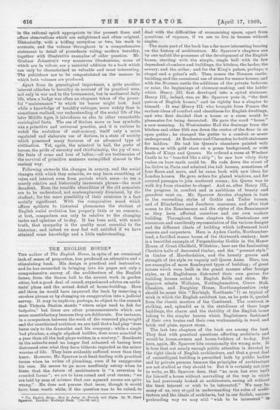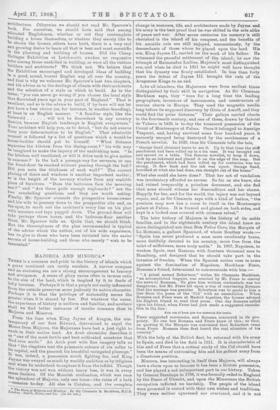THE ENGLISH HOUSE.* THE author of The English House, in
spite of an occasional lack of sense of proportion, has produced an attractive and a stimulating book. His design is practical and instructive, and he has succeeded in bringing iuto his pages not only a comprehensive survey of the architecture of the English house, from the Saxon hall to the newest work in garden cities, but a good deal of sound, experienced advice on archi- tects' plans and the actual detail of house-building. Here and there he would have improved the book by removing a careless phrase or by changing an exaggeration into a judicial survey. It may be captious, perhaps, to object to the remark that Victoria Station stands "where snipe used to fish for tadpoles," but there are other pronouncements which are more unsatisfactory because they are deliberate. For instance, in a comparison between the work of the censored playwright and the uncriticised architect we are told that a bad play "does harm only to the dramatist and his company ; while a single had plumber, a single slipshod builder, does more mischief in a year than all the bad plays written in a century." Residents in the suburbs need no longer feel ashamed at having been distressed over what they have hitherto regarded as the minor worries of life. They 'have evidently snffered more than they knew. However, Mr. Sparrow is at least dealing with practical issues when he writes of plumbing, even if he exaggerates his case. He seems to go more needlessly astray when he hints that the future of architecture is "a reversion to rounded forms"; we are to have round and oval rooms; "we are tout by men of 'science that our squared rooms are quite wrong." He does not pursue that issue, though it would have been worth while, if the question was to be raised, to
• The English House : How to Judge its Periods and Styles. By W. Shavr 13parrOvit. London: Eveeigh Nash. DOI. 6d. net.]
deal with the difficulties of economising space, apart from questions of expense, if we are to live in houses without angles.
The main part of the book has filar more interesting bearing on the history of architecture. Mr. Sparrow's chapters one by one unfold the processes of the development of the English house, starting with the simple, single hall with its few dependent chambers and buildings, the kitchen, the larder, the sewery, and the cellar ; and for the King's palace, perhaps, a chapel and a priest's cell. Then comes the Norman castle- building, and the occasional use of stone for manor houses, and with the Norman castle the additions of the private bedroom or solar, the beginnings of chimney-making, and the ladder
which Henry first developed into a spiral staircase. Henry III., indeed, was, as Mr. Sparrow puts it, "the first patron of English homes," and he rightly has a chapter to himself. It was Henry III. who brought from France the earliest ideas of comfort and cleanliness for English dwellings, and who first decided that a house or a room would ho pleasanter for being decorated. He gave the word "home" a new meaning. In Westminster Hall the drainage from the kitchen and other filth ran down the centre of the floor in an open gutter ; he changed the gutter to a conduit ov sewer underground. At Rochester and Clarendon he built staircases for ladders. He had his Queen's chambers painted with flowers, or with gold stars on a green background, or with heads of Kings and Queens. He ordered a room at Windsor Castle to be "boarded like a ship " ; he saw how vilely dirty rushee on bare earth could be. He rode down the street of La Greve in Paris and admired the tall houses, sometimes of four floors and more, and he Came back with new ideas for London houses. He gave orders for glazed windows, and for covered passages to join scattered rooms ; his Queen was to walk dry from chamber to chapel. And so, after Henry III., the progress in comfort and in ambitions of beauty and grandeur went on. Mr. Sparrow devotes chapters in turn to the succeeding styles of Gothic and Tudor houses, and of Elizabethan and Jacobean mansions, and after that comes to the Renaissance and the styles of the Renaissance as they have affected ourselves and our own modern building. Throughout these chapters the illustrations are numerous and excellently representative of the various designs and the different ideals of building which influenced local masons and carpenters. Here is Aydon Castle, Northumber- land, a fortified manor house of the thirteenth century; hem is a beautiful example of Perpendicular Gothic in the Manor House of Great Chalfield, Wiltshire; here are the fascinating Cheshire halls of decorated timber, and the "peasant style" in timber of Herefordshire, and the homely graces and strength of the style we vaguely call Queen Anne. Here, too, am examples of more flamboyant types of building ; of great houses which were built in the grand manner after foreign styles, as if Englishmen distrusted their own genius for building houses suited to English fields and skies. Mr. Sparrow selects Wollaton, Nottinghamshire, Crewe Hall, Cheshire, and Burghley House, Northamptonshire (why should he name this "Burleigh, Northants" P) as typical of work in which the English architect has, as lie puts it, quoted from the classic masters of the Continent. The contrast is striking, and, splendid as is the stateliness of these huge buildings, the charm and the stability of the English home belong to the simpler houses which Englishmen fashioned of their own brains and their owa workmanship in wood and brick and plain, square atone.
The last two chapters of the book are among the best. They deal with practical questions affecting architects and would-be house-owners and house-builders of to-day. But here, again, Mr. Sparrow hits occasionally the wrong note. It is true that not nearly enough public attention is devoted to the right ideals of English architecture, and that a great deal of unintelligent building is permitted both by public bodies and by private persons bemuse the principles of architecture are not studied as they should be. But it is certainly not true to write, as Mr. Sparrow does, that "no men has ever built . for hiMself a house without marvelling at the way in which he had previously looked at awhiteetare, seeing all without the least interest or wish to be interested." We may be, many of us, very stupid in understanding the rules of archi- tecture and the ideals of architects, but in our foolish, uncom- prehending way we may still "wish to be interested"
architecture. Otherwise we should not read Mr. Sparrow's book. For ourselves, we should have, said that among educated Englishmen, whether or not they contemplate building a house themselves, or whether they merely like to be shown the houses, others have built, there is a very real and growing desire to learn all that is best and most scientific In the planning and building of houses. Did the Cheap Cottages Exhibition at Letchworth awaken no responsive echo among those unskilled in building, or were all the visitors builders and architects ? We think not. We believe that the Exhibition encouraged and developed ideas of building la a good, sound, honest English way all over the country, and that is why we welcome Mr. Sparrow's last two chapters, and his advice as to the dealings of clients with theirarchitects and the selection of a style in which to build. As to the latter, "you can never go wrong if you choose the local style that flourished years ago in your part of England." That is excellent, and so is the advice to build, if by-laws will not let You have a free choice (as, for instance, in weather-boarding), at least in an English manner. " A familiar style, like the
Cotswold will not be discordant in any country district, because English landscape is English everywhere." Tour architect will help you, as to detail, "but do not swerve from your determination to be English." That admirable counsel is followed by a list of questions which a would-be bouse-builder should put to himself. " What distance separates the kitchen from the dining-room P" his wife may be imagined to make the inquiry of the unthinking man. "Is the kitchen well ventilated, or will it drive cook to give notice In summer P Is the ball a passage-way for servants, or can the front-door be reached without passing through the hall P bid you note the thickness of each wall?" The correct placing of doors and windows is another important matter ; eo le the height of the nursery window from any scalable Piece of furniture. "Does the bathroom face the morning BU n P" and "Are there quite enough cupboards? " are the two concluding questions, and they are worth asking. Pmally, Mr. Sparrow counsels the prospective house-owner and him wife to journey down to the prospective site and, on the spot, to mark out the architect's every lino on his plan with measure and tape pegged down. The ground-floor will take perhaps three hours, and the bedroom-floor another three, Mr. Sparrow tells us. Quite that, we should think. But the thoroughness of the plan renommended is typical of the advice which the author, out of his wide experience, bats to give to those who have been initiated into the easier !secrets of house-building and those who merely " wish to be Intres led."







































 Previous page
Previous page